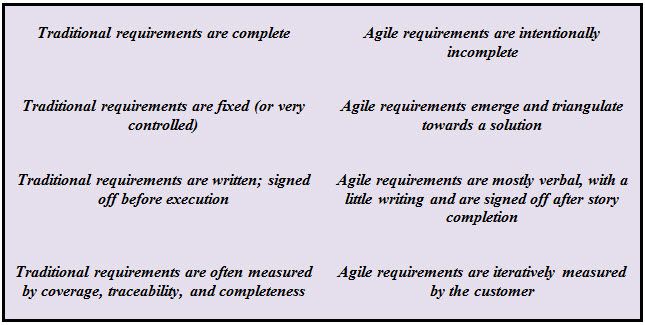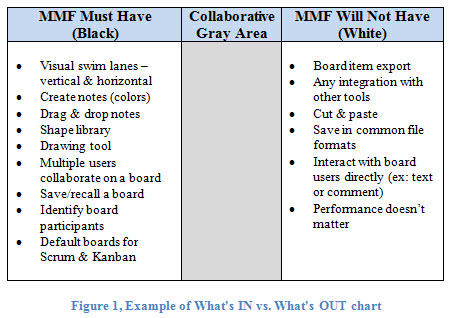The Agile BA: Predicting the Death of Micro–Management
 I was teaching a class a few weeks ago on Agile Methods. One of the crucial aspects of an introductory course, at least from my perspective, is an introduction to agile requirements. I usually start the discussion by trying to explain the large differences between traditional requirements and their agile equivalents.
I was teaching a class a few weeks ago on Agile Methods. One of the crucial aspects of an introductory course, at least from my perspective, is an introduction to agile requirements. I usually start the discussion by trying to explain the large differences between traditional requirements and their agile equivalents.
Now the end results each tries to steer towards are the same. But how they approach providing functional direction can be very, very different. Here is a table that tries to illustrate the primary differences:

One of the students really had a problem with this. We were doing a simulation around an iPad application. We developed a Minimal Marketable Product definition for an R1 release of the product. I then asked the student teams to write user stories in a story writing workshop. These stories were intended to align with the MMP they had defined. The next step in the class was to do a bit of release planning.
One of the teams pulled me aside and said that they were having a lot of difficulty with the exercise. In essence, they were struggling with the ambiguity and the lack of finely grained requirements. They were incredibly uncomfortable with aligning high-level stories with their MMP. Essentially—they wanted to be told what to do. Thinking and ideating on their own was simply too hard. It was also fraught with risk and responsibility.
In the class, I ‘forced’ them to try and deal with the ambiguity and complete the exercise. But it struck me that all they wanted was to be micro-managed.
Micro-Management
You all know what micro-management is from a leadership perspective. You’ve all probably worked for a micro-manager. They get involved in everything you do—looking over your shoulder, assessing your progress, and giving you advice at every turn. Usually the advice is staid and conservative. Aligning with how things have “always been done this way”. They don’t like anything that is risky or performed outside of their comfort zone. And usually, consistency in execution is very important to them.
Why don’t people typically like working for a micro-manager?
I think some actually do. Those employees with little experience, or drive, or desire to take ownership of their work. They embrace simply being told what to do, then do it, and then go home; satisfied that they met their boss’s expectations.
But in my experience, many more find this dissatisfying. It’s constrains them; limits their innovation, creativity, learning, risk-taking, experimentation, and yes, fun. Quite often it doesn’t drive the best results either.
But I need to get back to requirements. So what does micro-management have to do with requirements?
I think quite a bit. I think of traditional requirements as having many of the same attributes of micro-managers. They simply tell you what to do—in excruciating detail. There is no wiggle room, little area for thinking or discussion, and certainly there is no room for discussing option with the customers or creatively solving their problems.
Often, Business Analysts are the bosses with respect to traditional requirements. Sure, they try to be collaborative. But in the end, it’s their job to figure the direction out and describe it to the team. Then it’s the teams’ job to implement the product…as described and directed.
Agile or Not…Let’s Stop the Insanity
Whether you’re operating in traditional or agile environments or something in between, I’m now predicting the demise of this pattern of Requirement Micro-Management. And I hope it’s a ruthless, quick, perhaps painless, but permanent death. No matter how we approach it, it does need to stop.
Why?
Because it doesn’t work! You might ask what’s wrong with the traditional approaches to requirements. In answer, I might offer the following (non-exhaustive) list:
- They presume that a few can figure everything out
- They don’t easily adapt to change or discovery
- They don’t communicative well; writing being the primary medium
- They constrain innovation and creativity to only a few
- They imply that solutions are fixed
- They imply that teams simply follow the recipe; fostering little true collaboration
- They often miss the mark; disappointing customers
- They can be confusing; but impede asking questions
- They work more poorly as complexity rises
- They should be continuous rather than a leading activity
So, whether you’re agile or not, please consider adopting the mindset of agile requirements and putting behind the notion micro-managing requirements.
The world will be a better place for it and we’ll certainly create better products.
Thanks for listening!
Bob.
Don’t forget to leave your comments below.


 Many agile teams are familiar with the requirement artifact called the User Story. I often teach agile requirements in organizations and my favorite analogy for the user story is a lightweight use case on a 3×5 card. I tell everyone it’s not a ‘good’ analogy, but it does work for envisioning. Another way to look at a user story is that it defines an “executable chunk” of functionality that can be completed within a team’s sprint interval. So that bounds the story in size and complexity. It also dictates that it needs to be demonstrable in the sprints’ review; supporting a done-done state.
Many agile teams are familiar with the requirement artifact called the User Story. I often teach agile requirements in organizations and my favorite analogy for the user story is a lightweight use case on a 3×5 card. I tell everyone it’s not a ‘good’ analogy, but it does work for envisioning. Another way to look at a user story is that it defines an “executable chunk” of functionality that can be completed within a team’s sprint interval. So that bounds the story in size and complexity. It also dictates that it needs to be demonstrable in the sprints’ review; supporting a done-done state. Visually as we added something to the left, we’d need to either de-scope something or move it off to the (white) or (gray area) for further discussion. They are an implied BALANCE within the chart; that is the work detailed within the MMF is feasible for the team to deliver. And you might ask—who determines where it’s feasible? Why, the team themselves!
Visually as we added something to the left, we’d need to either de-scope something or move it off to the (white) or (gray area) for further discussion. They are an implied BALANCE within the chart; that is the work detailed within the MMF is feasible for the team to deliver. And you might ask—who determines where it’s feasible? Why, the team themselves!






 I want to discuss your value in this blog post. But in order to make the point and get your attention, I’ll shine the light initially elsewhere and then circle back around. We’ll see how this goes…
I want to discuss your value in this blog post. But in order to make the point and get your attention, I’ll shine the light initially elsewhere and then circle back around. We’ll see how this goes…


 I attended the
I attended the 